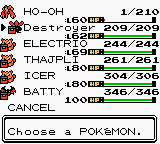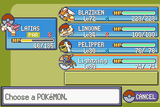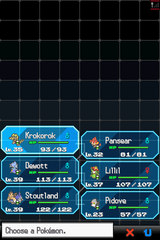Party: Difference between revisions
mNo edit summary |
|||
| Line 1: | Line 1: | ||
[[File: | [[File:BW Party.png|frame|right|Viewing a party in {{game|Black and White|s}}]] | ||
A '''party''' or '''team''' (Japanese: '''手持ちポケモン''' ''Pokémon on hand'') is a group of up to six {{OBP|Pokémon|species}} that a {{pkmn|Trainer}} carries with him or her. | A '''party''' or '''team''' (Japanese: '''手持ちポケモン''' ''Pokémon on hand'') is a group of up to six {{OBP|Pokémon|species}} that a {{pkmn|Trainer}} carries with him or her. | ||
| Line 21: | Line 21: | ||
===Generation I=== | ===Generation I=== | ||
In the [[Generation I]] games, there was no [[gender]], and so this is absent. Also, on the Pokémon Summary screens, there are only two screens: Stats, and [[Moves]]. The Moves section only shows the name, and the [[Power points|PP]] of each move. The icons were extremely limited, and the only Pokémon that had its own, unique icon was {{p|Pikachu}} (in {{game|Yellow}} only). | In the [[Generation I]] games, there was no [[gender]], and so this is absent. Also, on the Pokémon Summary screens, there are only two screens: Stats, and [[Moves]]. The Moves section only shows the name, and the [[Power points|PP]] of each move. The icons were extremely limited, and the only Pokémon that had its own, unique icon was {{p|Pikachu}} (in {{game|Yellow}} only). | ||
===Generation II=== | ===Generation II=== | ||
In [[Generation II]], color was introduced, along with gender, and both can be seen on the party screen. However, the icon range was still low, almost as restricted as Generation I. The Moves section of the summary allowed switching orders and power to be shown along with [[Elemental type|type]]. [[Power points|PP]] was still visible, and the party screen itself kept the same format. In {{game|Crystal}}, some Pokémon got unique party sprites, such as {{p|Snorlax}}. | In [[Generation II]], color was introduced, along with gender, and both can be seen on the party screen. However, the icon range was still low, almost as restricted as Generation I. The Moves section of the summary allowed switching orders and power to be shown along with [[Elemental type|type]]. [[Power points|PP]] was still visible, and the party screen itself kept the same format. In {{game|Crystal}}, some Pokémon got unique party sprites, such as {{p|Snorlax}}. | ||
===Generation III=== | ===Generation III=== | ||
In [[Generation III]] the party screen was overhauled, now with the first Pokémon on the left. Each and every Pokémon had its own unique icon, and all in color. The Pokérus status is visible on the party, unless another status ailment is present. The Moves section is again updated, with a page for [[Pokémon Contest]] moves, another for the moves when used in battle. The battle moves now show accuracy, power, type, and added effects. However, shiny Pokémon do not show the alternate colors in the party screen. The Pokémon leading the party is shown on the left side of the screen, while the other five are shown on the right side. | In [[Generation III]] the party screen was overhauled, now with the first Pokémon on the left. Each and every Pokémon had its own unique icon, and all in color. The Pokérus status is visible on the party, unless another status ailment is present. The Moves section is again updated, with a page for [[Pokémon Contest]] moves, another for the moves when used in battle. The battle moves now show accuracy, power, type, and added effects. However, shiny Pokémon do not show the alternate colors in the party screen. The Pokémon leading the party is shown on the left side of the screen, while the other five are shown on the right side. | ||
===Generation IV=== | ===Generation IV=== | ||
====Diamond, Pearl, and Platinum==== | ====Diamond, Pearl, and Platinum==== | ||
In these games, the party screen is changed again, showing the party Pokémon from left to right and top to bottom. All other things stay similar, with unique icons, but it adds condition to the summary pages. The party can also be viewed through the [[Pokétch]], to see either {{stat|HP}} and items, or Happiness. | In these games, the party screen is changed again, showing the party Pokémon from left to right and top to bottom. All other things stay similar, with unique icons, but it adds condition to the summary pages. The party can also be viewed through the [[Pokétch]], to see either {{stat|HP}} and items, or Happiness. | ||
====HeartGold and SoulSilver==== | ====HeartGold and SoulSilver==== | ||
In {{v|HeartGold and SoulSilver|s}}, the Pokémon that leads the party [[Walking Pokémon|follows]] the player around, like [[Red's Pikachu (game)|the Pikachu from Pokémon Yellow]]. | In {{v|HeartGold and SoulSilver|s}}, the Pokémon that leads the party [[Walking Pokémon|follows]] the player around, like [[Red's Pikachu (game)|the Pikachu from Pokémon Yellow]]. | ||
===Generation V=== | |||
====Black and White==== | |||
In {{v|Black and White|s}}, the party screen is now fully able to interact with the the [[Nintendo DS]]'s touch screen, by being placed on the bottom of the screen. It functions similarly as it did in previous games. | |||
==Gallery== | |||
{| align="center" style="background: #{{Black color light}}; {{roundy|10px}}; border: 3px solid #{{Black color dark}}" cellpadding="5" cellspacing="3" | |||
|- align="center" | |||
| style="background: #FFF; {{roundytop|10px}}"|[[File:Party level 10.png]] | |||
| style="background: #FFF; {{roundytop|10px}}"|[[File:GSC party.png]] | |||
| style="background: #FFF; {{roundytop|10px}}"|[[File:E party.png|160px]] | |||
|- align="center" | |||
! style="background: #{{Kanto color}}; {{roundybottom|10px}}" | {{color2|FFF|Generation I}} | |||
! style="background: #{{Johto color}}; {{roundybottom|10px}}" | {{color2|FFf|Generation II}} | |||
! style="background: #{{Hoenn color}}; {{roundybottom|10px}}" | {{color2|FFF|Generation III}} | |||
|- align="center" | |||
| style="background: #FFF; {{roundytop|10px}}"|[[File:Platinum Pokémon menu.png|160px]] | |||
| style="background: #FFF; {{roundytop|10px}}"|[[File:HGSSparty.png|160px]] | |||
| style="background: #FFF; {{roundytop|10px}}"|[[File:BW Party.png|160px]] | |||
|- align="center" | |||
! style="background: #{{Sinnoh color}}; {{roundybottom|10px}}" | {{color2|FFF|Pokémon Platinum Version|Platinum}} | |||
! style="background: #{{Johto color}}; {{roundybottom|10px}}" | {{color2|FFF|Pokémon HeartGold and SoulSilver Versions|HGSS}} | |||
! style="background: #{{Unova color}}; {{roundybottom|10px}}" | {{color2|FFF|Pokémon Black and White Versions|BW}} | |||
|} | |||
{{-}} | {{-}} | ||
{{Menu}} | {{Menu}} | ||
Revision as of 19:58, 20 May 2011

A party or team (Japanese: 手持ちポケモン Pokémon on hand) is a group of up to six Pokémon that a Trainer carries with him or her.
Overview
After this team of six is filled, newly-acquired Pokémon are sent to a PC to be stored. Trainers may have any Pokémon in their party, and newly captured Pokémon will automatically fill empty slots in the party. If a Trainer wishes to change Pokémon into or out of the party, he or she can; however, they must travel to a Pokémon Center or another PC-enabled place and use its Pokémon storage system to do so.
Battle
When entering a single battle, the first Pokémon that has not fainted in the party list is the one that will be drawn first. For double battles, the first two Pokémon that have not fainted in the party list are the ones that will be drawn first by the Trainer. During battle, if "Switch" is selected in Options, trainers can switch the participating Pokémon with another in the party.
Effects
All Pokémon in a Trainer's party will slowly gain trust towards him or her as the Trainer walks around; Every 256 steps, the party Pokémon gain happiness. Also, if there is an egg in the party, it will slowly hatch according to steps taken. Different eggs take different amounts of distance, but to hatch they must be in the party. They will not participate in battle; therefore a Trainer may only carry a maximum of five eggs at a time.
Some abilities have an out-of-battle effect, and these can only be activated if they are in a Trainer's party.
Pokérus
- Main article: Pokérus
If any Pokémon in the party are suffering from Pokérus, it can spread along the party, including eggs. However, Pokémon in the party will recover from Pokérus after midnight.
Variations
Viewing the party in the menu will display their name, icon, current HP, status ailment, and level in all games.
Generation I
In the Generation I games, there was no gender, and so this is absent. Also, on the Pokémon Summary screens, there are only two screens: Stats, and Moves. The Moves section only shows the name, and the PP of each move. The icons were extremely limited, and the only Pokémon that had its own, unique icon was Pikachu (in Pokémon Yellow only).
Generation II
In Generation II, color was introduced, along with gender, and both can be seen on the party screen. However, the icon range was still low, almost as restricted as Generation I. The Moves section of the summary allowed switching orders and power to be shown along with type. PP was still visible, and the party screen itself kept the same format. In Pokémon Crystal, some Pokémon got unique party sprites, such as Snorlax.
Generation III
In Generation III the party screen was overhauled, now with the first Pokémon on the left. Each and every Pokémon had its own unique icon, and all in color. The Pokérus status is visible on the party, unless another status ailment is present. The Moves section is again updated, with a page for Pokémon Contest moves, another for the moves when used in battle. The battle moves now show accuracy, power, type, and added effects. However, shiny Pokémon do not show the alternate colors in the party screen. The Pokémon leading the party is shown on the left side of the screen, while the other five are shown on the right side.
Generation IV
Diamond, Pearl, and Platinum
In these games, the party screen is changed again, showing the party Pokémon from left to right and top to bottom. All other things stay similar, with unique icons, but it adds condition to the summary pages. The party can also be viewed through the Pokétch, to see either HP and items, or Happiness.
HeartGold and SoulSilver
In HeartGold and SoulSilver Versions, the Pokémon that leads the party follows the player around, like the Pikachu from Pokémon Yellow.
Generation V
Black and White
In Black and White Versions, the party screen is now fully able to interact with the the Nintendo DS's touch screen, by being placed on the bottom of the screen. It functions similarly as it did in previous games.
Gallery
| File:Party level 10.png | 
|

|
| Generation I | Generation II | Generation III |
|---|---|---|
| File:Platinum Pokémon menu.png | File:HGSSparty.png | 
|
| Platinum | HGSS | BW |
| |||||||